- By YIKONG
- 2025-03-10 13:56:54
- TECHNICAL
Analysis on the construction of smart tire factory system! The important role of the steering wheel and the driver!
Analysis on the construction of intelligent logistics system based on the current situation of the tire industry
In recent years, the global and domestic tire markets have shown a steady growth trend. This article conducts a comprehensive and in-depth discussion on the key points and difficulties of the construction of the tire factory logistics system, the functional characteristics of logistics equipment in key manufacturing scenarios, as well as the transformation of key nodes in the upgrading of the logistics system of the old factory and the application of software and hardware technology. At the same time, in combination with specific cases, the significant effects achieved by intelligent logistics systems in improving production efficiency, reducing costs and optimizing management were explained in detail, and a systematic analysis of the future development trend of the tire industry and its impact on logistics system construction was conducted.
1. Overview of the development of the tire industry
1. Industry status and market size
The global tire market has been showing an expansion trend in recent years. According to statistics, the global tire market size is expected to reach US$230 billion in 2023, a year-on-year increase of 6.5%; and is expected to further grow to US$280 billion in 2024, with an annual compound growth rate of about 3.2%. As a major producer and consumer of tires in the world, China's automobile tire market size has exceeded 750 billion yuan in 2023, accounting for about 35% of the global market. During the same period, the tire production was about 988 million, with an annual growth rate of 15.3%. This series of data not only reflects the fierce market competition in the industry, but also shows the continuous improvement of product performance and production efficiency by the application of new technologies.
2. Technology progress and intelligent manufacturing transformation
With the application of new polymer materials, nanomaterials and other technologies in tire manufacturing, the products have been significantly improved in terms of wear resistance, anti-aging and safety performance. At the same time, the gradual promotion of automated and intelligent production lines has significantly improved production efficiency and product quality. The construction of smart factories has become an important way to enhance corporate competitiveness. By introducing information management systems and technical means such as the Internet of Things and big data, enterprises can realize digital management of the entire process of production, warehousing and logistics, thereby meeting the ever-changing market demand and enhancing the overall competitive advantage.
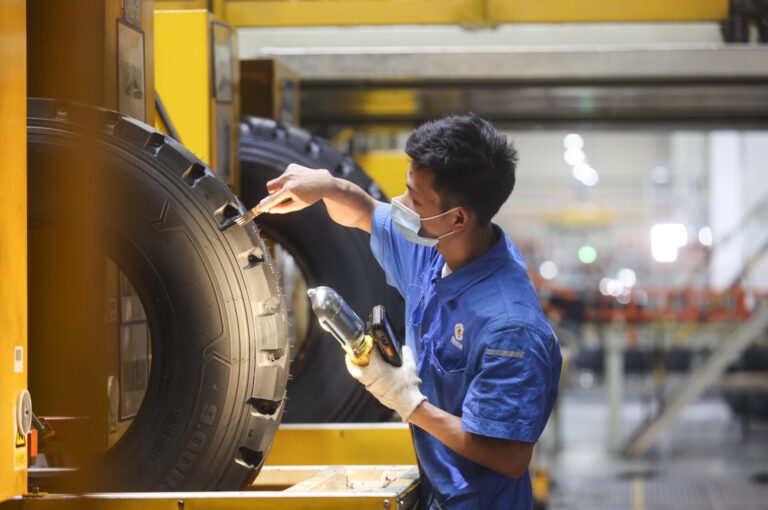
2. Construction of tire factory logistics system
1. Construction objectives and significance
The main goals of intelligent logistics systems in the construction of tire factories include the following aspects:
Shorten material handling time
Using AGV (automatic guided transport vehicle), automated three-dimensional warehouses and conveying equipment, efficient handling and precise distribution of materials such as rubber, components, etc., reducing delays and errors caused by manual operations.
Optimize production process and information linkage
Through seamless connection with production management systems such as MES and ERP, real-time synchronization of logistics information with production planning and inventory management is achieved, ensuring coordinated and efficient operation of all links, and reducing material waiting and processing delays.
Improve equipment utilization
Use automatic scheduling and intelligent control technology to reasonably arrange and efficiently schedule various logistics equipment to avoid idle equipment and ensure that production resources are maximized.
Reduce labor costs and risks
Replacement of manual handling and warehousing operations by automated equipment not only reduces labor costs, but also reduces the safety risks of personnel in high load or complex production environments.
Improve product quality and stability
Through precise material identification and positioning, the risk of material confusion and damage caused by human error is reduced, thereby ensuring the quality of finished products and production continuity.
Reduce logistics operation costs
Monitor inventory status in real time, optimize transportation paths, reduce warehousing backlog and transportation costs, and improve the economic benefits of the overall logistics system.
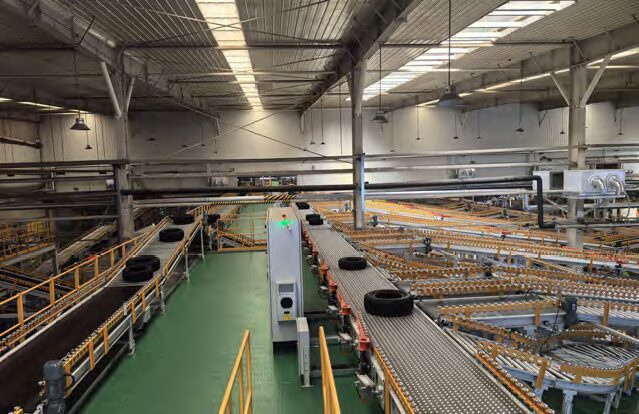
2. System composition and core technology
The tire intelligent factory logistics system mainly consists of two parts: software system and hardware equipment.
Software System
Including warehouse management system (WMS), warehouse control system (WCS), etc., it is responsible for data collection, task scheduling and information integration. These systems integrate with enterprise management platforms such as ERP, MES, PLM to achieve seamless information connection between production, warehousing and distribution, and can use big data analysis to dynamically optimize logistics paths and inventory structures.
Hardware equipment
It mainly covers automated three-dimensional warehouses, AGV trolleys, conveyor lines, hoists, stackers, gantry picking robots, air conveying systems (EMS), as well as information collection equipment such as RFID tags and readers. These equipment are specially designed according to the needs of different production links. They have the characteristics of high load, high precision, stability and reliability, and can operate stably for a long time in complex environments such as high temperature and high humidity.
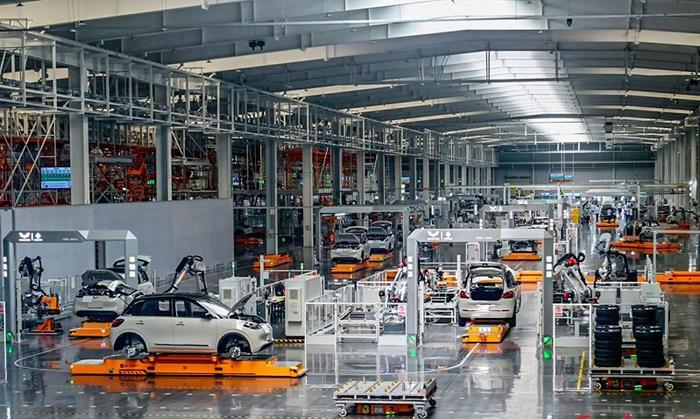
3. Design Points and Challenges
In system design, there are the following key points and difficulties that need to be paid attention to:
System integration and collaborative work
The logistics system needs to be closely integrated with various information systems within the enterprise to realize real-time data sharing. Accurate coordination is required between each automation equipment to ensure smooth transmission of materials between different processes and avoid information faults or equipment conflicts.
Selection and layout of automation equipment
According to the production process and material characteristics, rationally select automation equipment with high load capacity and stable accuracy, and make scientific layouts to reduce the transportation distance and time between equipment and improve overall efficiency.
Intelligent data collection and control
Through RFID, sensor and other technologies, material and equipment status data are collected in real time, and intelligent algorithms are used to optimize paths and task scheduling to realize automated management and dynamic adjustment of logistics operations.
Technical complexity and system stability
In high-precision real-time positioning and complex environments, the logistics system must ensure high stability and anti-interference capabilities. Any failure in a single link may cause interruptions to the entire system, so the redundant design of the system and the rapid fault diagnosis mechanism are crucial.
High investment and talent training
Comprehensive intelligent transformation requires a large amount of capital investment, and it is also necessary to cultivate compound talents who understand production processes and are proficient in logistics automation to ensure that the system can operate stably for a long time.
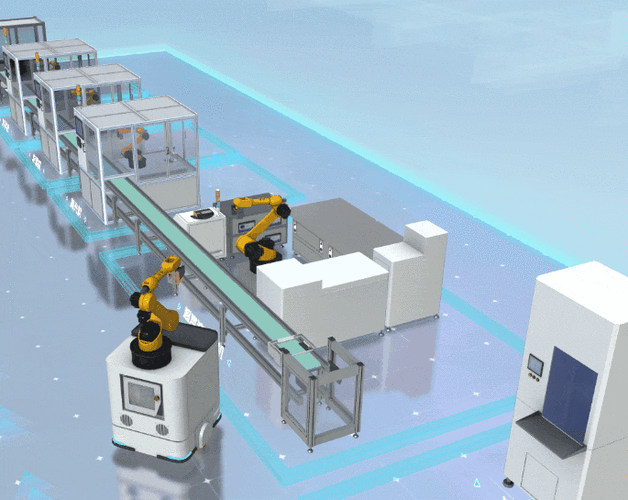
3. Logistics equipment and functional characteristics in key scenarios of tire manufacturing
1. Equipment application in each key production link
In the tire manufacturing process, different processes have their own emphasis on the demand for logistics equipment:
Glue refining workshop
Use AGV trolleys and automated three-dimensional warehouses to achieve rapid handling and precise storage of rubber and auxiliary materials, ensuring timely and continuity of raw material supply.
Forming workshop
Relying on the aerial suspension conveyor trolley and one-way circulating roller chain system, the automatic conveying of large-sized film and tread is realized to ensure smooth and continuous material flow during the forming process.
Vulcanization workshop
Since the sulfurization process has high temperature and time requirements, precise handling is particularly critical, and high-precision AGV equipment is used to ensure the stable transportation of molds and semi-finished products.
Finished product storage
Equipment such as automatic three-dimensional warehouses and stackers not only realize high-density access operations, but also realizes effective control of inventory management and operation safety through intelligent scheduling systems.
2. Equipment performance requirements and key technologies
In response to the needs of special tire production processes, logistics equipment needs to focus on the following aspects in design:
High load capacity
In view of the large amount of heavy-duty rubber, steel wire and tread materials used in tire production, the equipment must have sufficient load capacity to meet the needs of long-term high-strength handling.
High-precision positioning and stability
In production links such as vulcanization, which require extremely high process accuracy, the positioning accuracy of the equipment is directly related to product quality. Adopting advanced positioning technology and stable transmission system is the key to ensuring operational accuracy.
Adapt to complex process
Tire production involves multiple processes and multiple specifications of materials. Logistics equipment needs to have multi-spec management capabilities and flexible adaptability to ensure efficient connection between different production stages.
Safety and reliability
The equipment not only needs to meet the requirements of efficient handling, but also must have complete safety protection measures, such as anti-collision, anti-missive operation and other functions to ensure the safety of the operating environment.
Information and intelligent management
By integrating RFID, sensors, machine vision and other technologies, logistics equipment can collect and feedback job data in real time, use big data and intelligent algorithms to optimize paths and equipment scheduling, and realize intelligent management of the entire process.
Technical support for key components
During the smart factory transformation process, high-performance steering wheels and drivers played an irreplaceable role as core transmission and control components in logistics automation systems. They not only ensure the efficient and stable operation of AGV and other equipment in complex production environments, but also optimize logistics paths and equipment scheduling with advanced intelligent regulation technology, thereby improving overall transportation efficiency and reducing energy consumption, providing solid technical support for the factory's digital transformation.
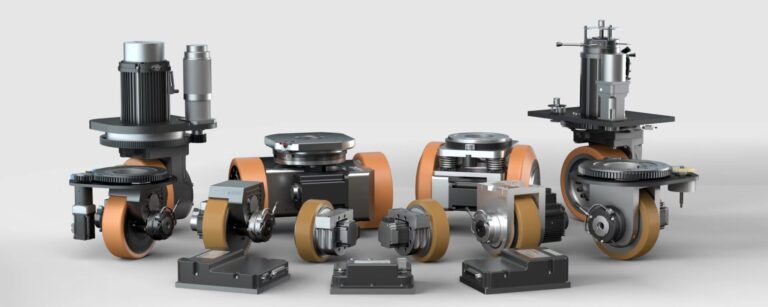
4. Upgrading and transformation of logistics systems in old factories
When traditional tire factories face the wave of intelligent manufacturing, there are problems such as aging logistics system, insufficient equipment performance and low level of informationization. To this end, the upgrade and transformation mainly revolve around the following four key aspects:
1. Renovation of the warehousing system
Structural optimization and capacity expansion
In response to the problems of insufficient warehouse locations and outdated structures in existing three-dimensional warehouses, by adjusting the shelf structure and increasing the number of warehouse locations, the storage capacity and operating efficiency are improved.
Introducing automated three-dimensional library
Fully automated three-dimensional libraries are built in some old factories to realize unmanned storage and management of raw materials and finished products, and ensure the continuity and efficiency of logistics operations.
2. Upgrade of the conveying system
Technical transformation of conveyor lines
Technical upgrades to the old conveyor lines to improve conveying speed and stability, and ensure that time losses and safety hazards are reduced during material transfer.
Application of air conveying system
In key links such as molding and sulfurization processes, an air conveying system (EMS) is introduced to achieve efficient transportation and precise positioning of large materials such as fetal embryos to meet the efficient logistics needs in complex production environments.
3. Update and replacement of handling equipment
AGV car and robot upgrade
In response to the shortcomings in load capacity and positioning accuracy of traditional AGVs, technical transformation and optimization and upgrading are carried out to improve the equipment's ability to adapt to complex handling tasks.
At the same time, the robot is improved to improve its flexibility and stability, and achieve more efficient material loading and unloading operations.
4. Comprehensive upgrade of software system
WMS and WCS system transformation
Upgrade and transform the existing warehouse management system (WMS) and warehouse control system (WCS) to achieve deep integration with MES, ERP and other systems, and improve data processing speed and information transparency.
At the same time, big data and artificial intelligence technology are used to intelligently optimize inventory management, logistics paths and equipment scheduling to achieve real-time monitoring and dynamic management of the entire process.
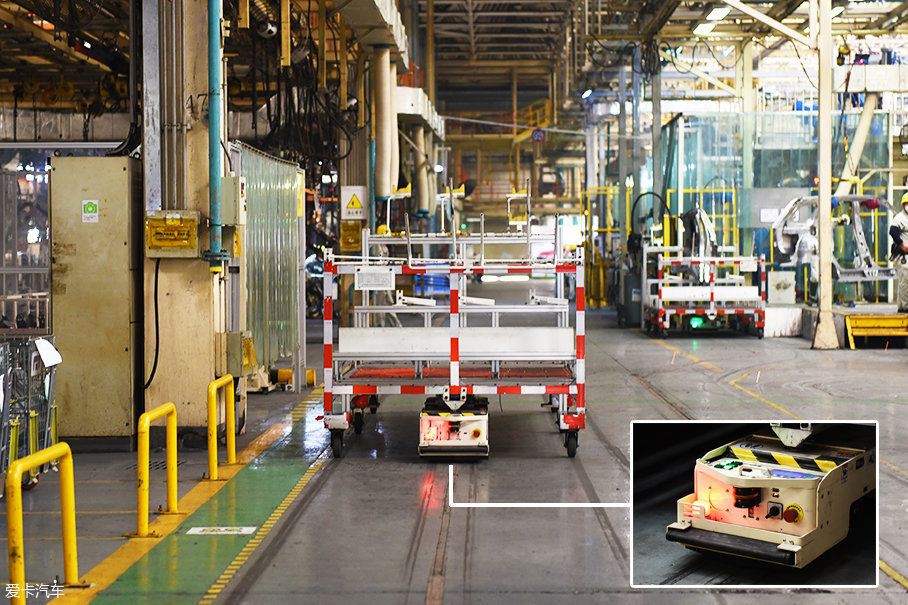
5. Application cases and actual effects
In recent years, with the continuous maturity of intelligent manufacturing technology, many tire manufacturers have invested a lot of resources in logistics system transformation and achieved remarkable results. By introducing advanced equipment such as fully automatic three-dimensional libraries, AGV cars, smart stackers, etc., and combining with an information management system, a comprehensive upgrade from material handling to warehousing management has been achieved. The specific effects are reflected in the following aspects:
Significant improvement in production efficiency
The application of automation equipment greatly shortens the time from incoming and outgoing materials, ensures seamless connection between various production links, and effectively reduces production waiting time and bottleneck phenomena.
Effective reduction of operating costs
Reliance on manual handling and labor costs are reduced; at the same time, the application of intelligent scheduling systems has also optimized transportation paths and equipment utilization, thereby reducing energy consumption and logistics costs.
Improvement of operational accuracy and product quality
With the help of RFID and machine vision technologies, the logistics system can achieve accurate identification and positioning of materials, significantly reducing the risk of material confusion and damage caused by human factors, and ensuring the stability of product quality.
Scientific and precise inventory management
Through real-time data monitoring and big data prediction, the logistics system can dynamically manage the inventory status, effectively avoiding the phenomenon of overstock or out of stock, and improving the capital utilization rate and warehousing turnover rate.
Improvement of safety and environmental benefits
The automated warehousing system not only reduces the work of personnel in high-risk environments, but also provides real-time security warning for the warehousing environment. Coupled with optimized energy consumption management, it realizes a more environmentally friendly production process.
6. Future development trends and the impact of logistics system construction
Looking ahead, with the continued increase in global car ownership and the rapid rise of the new energy vehicle market, the demand for tire market will continue to grow, and intelligent manufacturing and digital transformation will become an inevitable trend in the development of the industry. This puts higher requirements on the construction of logistics system, mainly reflected in the following aspects:
Warehousing capacity and automation requirements are constantly increasing
As the production scale expands, enterprises' requirements for warehousing capacity and storage and access speed will be further improved, and it is necessary to build larger-scale and higher-level warehouses.
Improved logistics distribution frequency and efficiency
Quickly responding to market demands has put forward high-frequency distribution requirements for the logistics system, requiring the system to complete the scheduling and distribution of large batches of materials in a short time.
In-depth application of intelligent management
In the future, logistics systems will rely more on technologies such as big data and artificial intelligence to realize dynamic monitoring, prediction and intelligent scheduling of the entire process, thereby further optimizing logistics paths and operation plans.
Comprehensive promotion of green environmental protection concept
Against the backdrop of global energy conservation and emission reduction, the logistics system will adopt more environmentally friendly materials and low-carbon transportation methods to promote the recycling of resources and achieve the development of green logistics.
The core role of key equipment in improving efficiency
As the core transmission and control components in the logistics automation system, the high-performance steering wheel and driver will increasingly highlight their role in optimizing logistics paths, improving equipment scheduling efficiency and reducing energy consumption, providing continuous technical support for the overall intelligent logistics system.
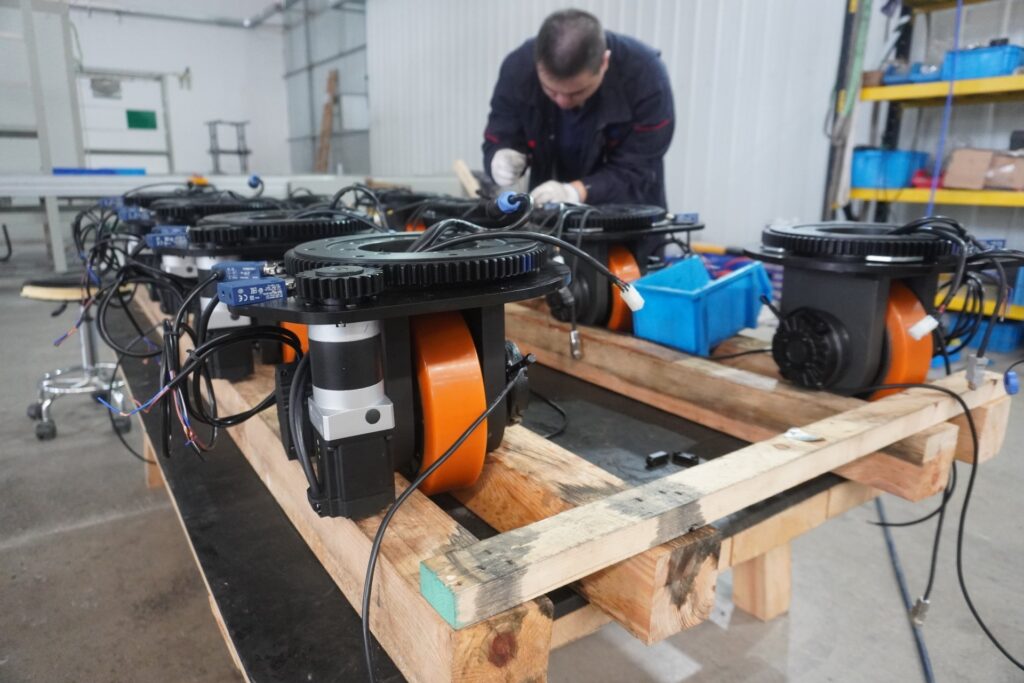
Overall, the intelligent logistics system of tire factories in the future will not only be an important means for enterprises to improve production efficiency and market competitiveness, but also an important engine to promote the transformation of the entire tire industry to efficient, environmentally friendly and digital. Through continuous technological innovation and system optimization, the industry will achieve comprehensive coordinated upgrades in logistics, production and management, and win greater advantages for enterprises in global competition.



